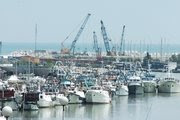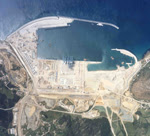Morocco is a country with over 3,000 kilometres of coastline; 95% of its foreign trade passes through the Kingdom's 30 ports. After the 1970s, the political authorities made significant investments to equip Morocco with adequate port infrastructures, carrying out a strategy of port specialisation. However, as well as leading to inflexibility in their range, this also created difficulties for the ports in terms of adaptation to the rapid changes taking place in the maritime transport market.
As a result, a new ports policy - the National Port Master Plan - was defined, with the following main objectives: to create a new port in the Straits of Gibraltar, 35 kilometres from Tangiers; and to improve the other Moroccan port areas.
This led to the Tánger - Méditerranée project, a complex of integrated infrastructures at a strategic position in northern Morocco (15 kilometres from the European Union, on one of the major shipping routes), and included in the Special Economic Zone, which consists of: a new port, a free trade logistics area and the relevant connection infrastructure in the region.
This major project is backed by a nearby market of over 600 million inhabitants, and as such, for the year 2020, traffic of 3 million TEUs is anticipated, as well as private investment worth 1,000 million Euros, and the creation of 145,000 jobs.
Tanger-Med, a hub port
The Tanger-Med port has been designed as an exchange platform and hub port, especially for container transfer work, which is experiencing significant growth in the Mediterranean.
There are two main objectives for the Tanger-Med port; on the one hand, to absorb the container transfers of the main shipping lines with East-West and North-South traffic; and on the other, to carry out the transfers with neighbouring regions as a destination, such as the eastern Mediterranean, and northern and western Africa.
Tanger-Med will have various infrastructures:
a container terminal for transfer traffic and import-export traffic, with a 1,610-metre quay.
a ro-ro terminal for passenger traffic and TIR traffic - an estimated 2.5 million passengers and 100,000 lorries per year
a terminal for various bulk goods, especially for cereals
a hydrocarbons terminal, which will be used to redistribute products refined in the North, and will supply ships from the shipping companies sailing through the Strait of Gibraltar
Tanger-Med, a wide range of free trade areas
The Tanger-Med project will also includes a wide range of range free trade areas, which will allow added value activities to be generated effectively in the region. The free trade areas have been designed along three lines:
Logistics Free Trade Area: next to the containers terminal, it will have an area of 138 hectares and a customs area. Only logistics and transformation activities will take place.
Industrial Free Trade Area: an extension of the Tangiers free trade area, it will be situated 20 kilometres from the new port and will have an area of 600 hectares. Operators and transformation industries geared to exportation will establish themselves there.
Commercial Free Trade Area: located 18 kilometres from the new port and near the town of Fnideq, will have an area of 200 hectares. Business to business activities linked to the logistics free trade area will take place there, and will enable duty free shopping centres to be established.
Connection infrastructures
In order to link the new port and the various free trade areas, as well as connecting Morocco's economic and business fabric, the Tanger-Med project also includes the construction of connection infrastructures, of which the most significant are:
a 61-kilometre motorway linking the new port with the northern Tangiers-Casablanca motorway
a 45-kilometre railway connection between Tangiers and the future port-free trade area
a quick route linking the port and the town of Fnideq, and the free trade area located 18 kilometres away
Financing and public and private investments
An initial distribution of the public investments necessary for the financing of Tanger-Med established that the project would require a total of 1,400 million Euros, broken down as follows:
Tanger-Med Port Infrastructures: 450 million Euros
Free trade area infrastructures: 250 million Euros
Connection infrastructures: 600 million Euros
Others (energy, water…): 100 million Euros
The main financing sources were determined by:
180 million Euros from the Hassan II funds, and 270 million Euros from the Abu Dhabi Funds for the Tanger-Med Port infrastructure
153 million Euros from FADES, and 80 million Euros from FKDEA for land infrastructure connections
other funds from the BID, ADF and Moroccan banks for railway connections
As regards private enterprise, it was decided that investments of 1,300 million Euros need to be made, distributed in 300 million Euros for the new Port and 1,000 million Euros in the free trade areas.
2002, the starting point
In 2002, the Moroccan Government created a 550-square kilometre Special Development Zone, to promote access to foriegn markets for companies in Morocco, and the development of their future logistics processes, as well as to contribute to the boosting of the Moroccan economy and the development of tourism in the region.
In order to carry out, co-ordinate and administer the macro-project, the Tánger-Méditerranée Special Agency (TMSA) was established in September 2002. This is a private company with public privileges, art which works based on an agreement with the State, and interacts with the various Ministries involved.
In 2003, the agreement between TMSA and the Moroccan State was signed for a 50 year period, by virtue of which TMSA is responsible for awarding the contracts for port and logistics activities, while the State undertakes to build the connection infrastructures. TMSA is able to delegate some port activities to private investors, and is the sole agent with which companies wanting to establish themselves in the special economic zone deal with. For example, it can grant construction permits or give work authorisations.
Also in 2003, TMSA guaranteed its initial financing of 500 million Euros, and signed a contract worth 215 million Euros, with a consortium headed by the businessman Bouygues for the the construction of the port and its basic infrastructures.
Tanger-Med, ready in 2007
During 2004, the first financial operations and partnership operations took place for investment companies and those working in the Tanger-Med free trade areas. In specific terms, in October, the Tánger-Méditerranée Special Agency (TMSA) and Jebel Ali Free Zone International (JAFZI) signed a partnership and co-operation agreement for a ten-year period, to make Tanger-Med into a benchmark multimodal platform in the Mediterranean. This strategic, operational and commercial agreement stipulates that JAFZI and TMSA will promote Tanger-Med internationally to attract multinationals who can establish themselves on the two platforms.
Also in 2004, the tendering process for the hydrocarbon terminal and the tug service was opened, and the contract for the first container terminal was awarded.
During 2005, the contract for the second container terminal, the hydrocarbon dock and the tug service will be awarded. The following will also be established: the Tanger-Med Port Authority, the Tanger-Med Free Trade Areas Investment Company, and the Tanger-Med Free Trade Areas Authority.
The port construction works are planned for completion in 2006; while in 2007 the area's superstructures, land and railway connections will be completed. The commissioning of the port is also planned for July 2007, as is the beginning of work in the Logistics free trade area.
First container terminal and tendering process for the second
On 23 November 2004, the Tanger Méditerranée Special Agency (TMSA) awarded the contract for the first container terminal in the Tanger-Med port the consortium formed by APM Terminals, a company belonging to A.P. Moller-Maersk Group and Akwa Holding. The concession, in which the Maersk group has a 90% holding, is valid for a 30-year period. The consortium which will run the terminal will also the invest a total of 120 million Euros until 2007, and this figure will reach 150 million Euros in 2010. The first container terminal in the Tanger-Med port is 40 hectares in area, with an 800-metre dock.
After the contract for the first container terminal was awarded, in December 2004 TMSA decided to begin the tendering process for the second terminal, and the same bidders as in the first tender process were able to take part in this second tender, except for the consortium winning the contract for the first terminal. Among other offers, the group consisting of CMA-CGM, Evergreen, P&O Ports and Terminal Link was a bidder.







